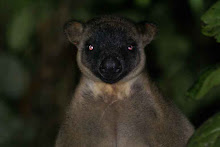When we take people on wildlife tours, we are often asked, "what's the difference between a kangaroo and a wallaby?".
Although the answer given by many would be size (i.e. the kangaroos being bigger than wallabies), the answer isn't always that simple. Let me explain...
Although the answer given by many would be size (i.e. the kangaroos being bigger than wallabies), the answer isn't always that simple. Let me explain...
 |
| A red kangaroo |
Kangaroos are larger than wallabies, and wallabies are often more squat or solid - whereas kangaroos are not only larger but also longer and leaner. Kangaroos also have a distinctive black naked rhinarium - you know, the wet part of a dog's nose for example. The largest of the kangaroos is the red kangaroo - large males can weigh up to 80 kilograms. The other large kangaroos are the eastern grey and the western grey kangaroos. However, there are also tree-kangaroos - these are wallaby-sized kangaroos that live in trees, and there are rat-kangaroos which are small rat or guinea-pig sized kangaroos.
 |
| A young red-necked wallaby |
On the other hand, there are numerous species of wallabies - each eeking out a niche in its particular habitat - whether rainforest, grasslands, alpine regions, rocky-cliff faces, etc. Wallabies makes up the majority of the macropod family - in fact, there are about 30 species of wallabies found in Australia - including rock wallabies, swamp wallabies, hare-wallabies and lots of other wallabies! And everybody knows that Australia's mighty rugby side is also called the wallabies (don't they?)!
 |
| a common wallaroo |
Just to confuse the matter, there are also wallaroos - an animal that has some features of both wallaby and kangaroo. Most wallaroos are medium sized but one of these, the Antilopine wallaroo, grows to almost as large as the red kangaroo! Wallaroos also have a black naked rhinarium like kangaroos and come in all colours - red, grey, brown, black and various combinations and shades of these.
Bye for now...
Images all courtesy of wikipedia.com













